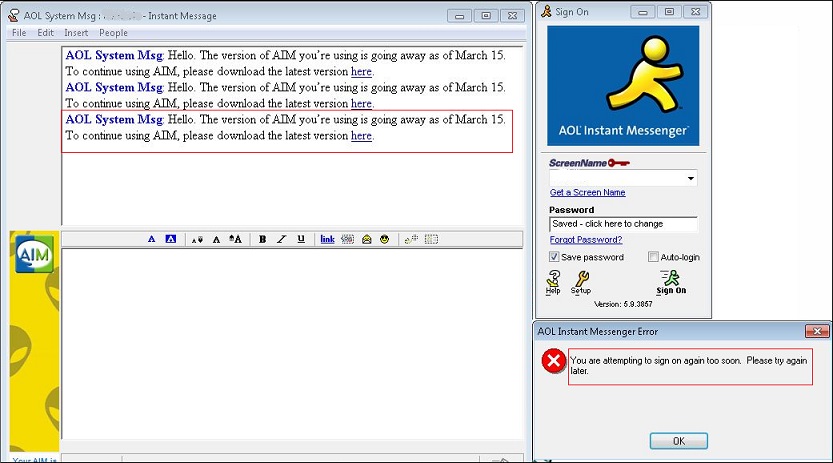

There is no question that the Internet has transformed the way the world communicates, especially after people began to adopt Instant Messaging (IM) in huge numbers back in the 1990s.
The ability of being able to use your computer to fire off a quick IM to a friend or colleague, without the need to dig out a mobile phone number to send a SMS message, or open up an email program and look up their email address, was a very attractive proposition to computer users contending with often painfully slow (and not ‘always-on’) dial-up Internet.
Which makes the fact that the iconic messaging program AOL Instant Messenger (AIM) was closed down last week on 15 December, worthy of a Tales In History examination.
AIM was created by AOL in May 1997 and rapidly established itself as the most popular service in the US, with its famous “Running Man” mascot logo.
AIM was the result of three men, Barry Appelman, Eric Bosco and Jerry Harris, all of whom worked at AOL in the 1990s and early 2000s as engineers. It should be noted that they were not employed to build a messenger product. Indeed, when they showed their creation to AOL management, they received a distinctly lukewarm reception.
Appelman and Bosco were Unix programmers, whereas Harris had been a programmer at a small web browser company purchased by AOL. The main driver for AIM however seems to have been Barry Appelman.
He was a former IBM staffer, and during his time at Big Blue he had worked on some of the first standards to connect computers over the Internet (Transmission Control Protocol/Internet Protocol or TCP/IP).
Before they developed AIM, Appelman created the buddy list. Vack in 1994, AOL operated a very commercial dial-up Internet service that charged users an hourly fee when they were connected.
Unlike many systems of that period, AOL could tell who was online due to the way its system was built.
But the typical AOL user had to manually search for other online friends, using their exact screennames.
Appelman had the idea that instead of users manually searching for their friends, he would develop a program to tell users when their friends were online.
He then created the Buddy List without informing anyone, even AOL’s management.
In October 1996 AOL switched from charging an hourly rate to a flat fee. This meant that being online was no longer an expensive option, and people could suddenly spend much longer online.
But this placed a strain on AOL infrastructure and servers began crashing. Eric Bosco had been seeking a project to work on at AOL, and had begun (again without AOL’s knowledge) to explore the idea of a messenger that existed beyond the walled garden service of AOL.
Basically, it was an internal Skunkworks projects that management had no clue about.
But they needed some hardware for their project. Appelman reportedly called in a favour to the head of AOL’s data centres, who happened to have some old Hewlett-Packard servers he’d planned to ship back to HP.
His friend agreed to “lose” the machines so the AIM team could use them in an unofficial capacity.
Bosco and Appelman thus developed AIM, but when they finally showed the unsanctioned product to AOL, the executives were not best pleased.
Find out more on Page 2…
Page: 1 2
Apple fined 150m euros over App Tracking Transparency feature that it says abuses Apple's market…
OpenAI to release customisable open-weight model in coming months as it faces pressure from open-source…
Samsung's Bespoke AI-powered fridge monitors food to create shopping lists, displays TikTok videos, locates misplaced…
Huawei sees 38 percent jump in consumer revenues as its smartphone comeback continues to gather…
In world-first, China approves commercial flights for EHang autonomous passenger drone, paving way for imminent…
Microsoft closes down IoT and AI lab it operated in Shanghai tech district in latest…